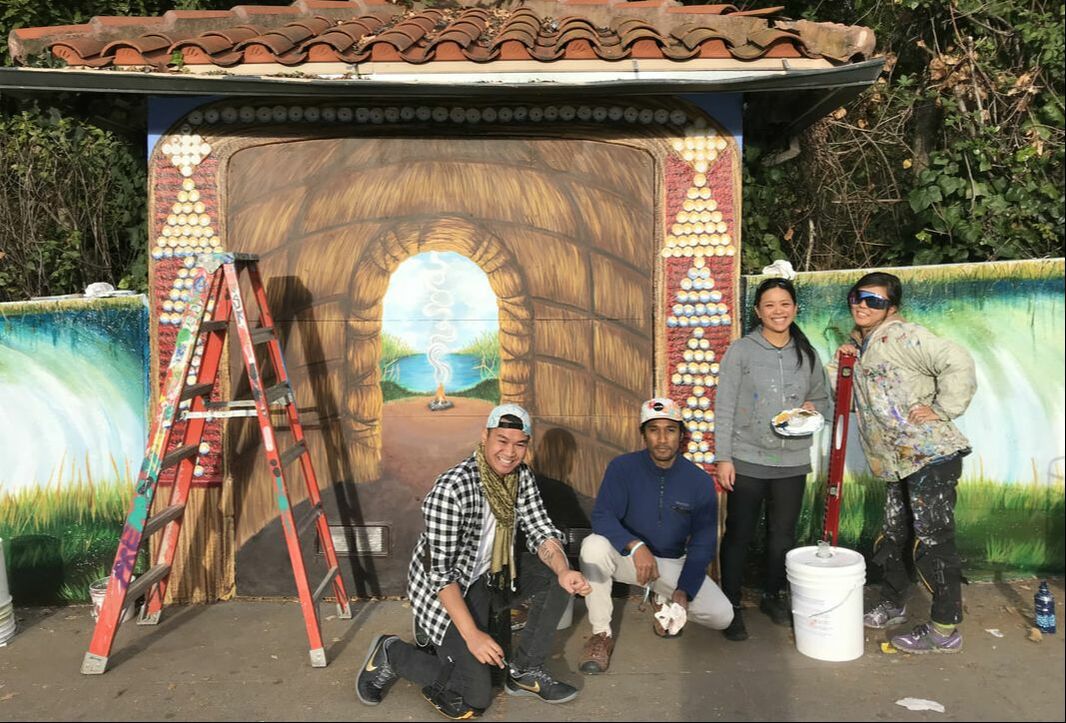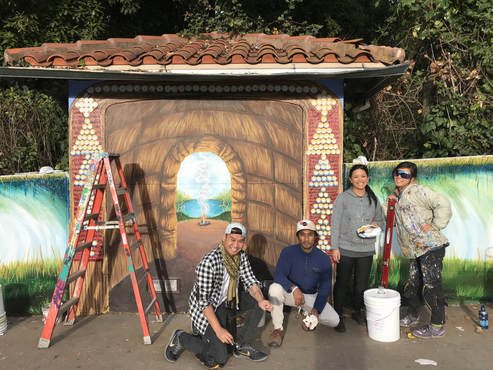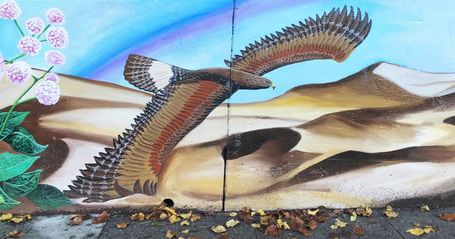|
Newest Segment of Laguna Honda Epic Mural Completed
The mural takeover of the retaining wall of the Laguna Honda Hospital is complete! The new 200-foot segment begins at the corner of Laguna Honda Blvd and continues up the hill along Woodside Ave. Titled "We All Grow Resilient," the work was designed and coordinated by Precita Eyes lead artists Julia Barzizza and Deirdre Weinberg, with Flavia Mora. As is traditional in this ongoing project, a host of friends, neighbors and aspiring muralists brought their ideas and paint brushes to community sessions. Started in 2016 to celebrate the 150th anniversary of the city's oldest hospital, successive stages of the mural have been funded by residents of District 7, through its participatory budget process. The visual epic tells the natural history and human story of the Laguna Honda hill and stream, from the time of its first-known inhabitants to the present. The work is a veritable compendium of the flora and fauna of the site, including endangered species and scenes of traditional Ohlone life. As one walks up the hill, the viewer time travels through Rancho San Miguel, to the first municipal poorhouse and hospital, to the tunnel and trains that connect the westside neighborhoods around Twin Peaks and Sutro Tower to downtown SF and into the future. The full mural is some 800 feet long, making it one of the longest in the city, and taking it all in by walking uphill takes a full 20 minutes. |
The Laguna Honda Hospital Mural:
A Long Walk Through Local Landscapes and History
A Long Walk Through Local Landscapes and History
Native flowers (mariposa lily, Douglas iris, rose hips) and the SF Department of Public Works goats.
The 600-foot mural follows the contours of a retaining wall at the base of a steep hill. It's next to impossible to get a full panoramic view of the mural and not get hit by a car. Just walking alongside it takes a good 15 minutes.
This is the Laguna Honda Hospital mural, completed in February by a team of Precita Eyes artists and community members. At its base, the mural opens onto the world of the Ohlone before the arrival of Spanish settlers, then traverses the history of the site from the Rancho San Miguel land grant, the first municipal poorhouse and hospital, the tunnel and trains that connect the west side neighborhoods of Twins Peaks, Sutro Tower, the Midtown Terrace, West Portal and Forest Hill, and, in the horizon, downtown San Francisco, the Pacific Ocean, and the future.
The mural's exuberant flora and fauna are already celebrated, with one of its Great Blue Herons on the cover of Bay Nature magazine, a tribute to the scientific rigor of its imagery.
"The job of an artist is to visualize a story," says lead muralist Elaine Chu, who partnered with her Precita Eyes colleague Yuka Ezoe on the project. Both are star collaborators with Precita Eyes Muralists, with Ezoe heading its education program and Chu playing a coordinating role. In addition to their prolific output with Precita Eyes, both are sought-after artists with their own mural enterprises. (Chu is half of Twin Walls Mural Company; and Ezoe is half of Bahama Kangaroo. )
The Laguna Honda mural has been "a journey of research, funding, community building, chipping walls and nonstop painting in the heat and cold," says Chu. It began when the hospital commissioned Precita Eyes to paint a mural marking its 150th anniversary, celebrated in 2016, and its legacy of care to San Franciscans in need.
Initial funding came from the Tides, Zellerbach Family and Fleishhacker foundations. The second and third stages were funded by SF District 7 participatory budgeting grants, with local residents voting it as their favorite project.
"We were lucky to have met Supervisor Norman Yee at a Midtown Terrace neighborhood block party," says Chu. "He loved our mural idea and encouraged us to apply. So we gave it a try."
Read full interview HERE
This is the Laguna Honda Hospital mural, completed in February by a team of Precita Eyes artists and community members. At its base, the mural opens onto the world of the Ohlone before the arrival of Spanish settlers, then traverses the history of the site from the Rancho San Miguel land grant, the first municipal poorhouse and hospital, the tunnel and trains that connect the west side neighborhoods of Twins Peaks, Sutro Tower, the Midtown Terrace, West Portal and Forest Hill, and, in the horizon, downtown San Francisco, the Pacific Ocean, and the future.
The mural's exuberant flora and fauna are already celebrated, with one of its Great Blue Herons on the cover of Bay Nature magazine, a tribute to the scientific rigor of its imagery.
"The job of an artist is to visualize a story," says lead muralist Elaine Chu, who partnered with her Precita Eyes colleague Yuka Ezoe on the project. Both are star collaborators with Precita Eyes Muralists, with Ezoe heading its education program and Chu playing a coordinating role. In addition to their prolific output with Precita Eyes, both are sought-after artists with their own mural enterprises. (Chu is half of Twin Walls Mural Company; and Ezoe is half of Bahama Kangaroo. )
The Laguna Honda mural has been "a journey of research, funding, community building, chipping walls and nonstop painting in the heat and cold," says Chu. It began when the hospital commissioned Precita Eyes to paint a mural marking its 150th anniversary, celebrated in 2016, and its legacy of care to San Franciscans in need.
Initial funding came from the Tides, Zellerbach Family and Fleishhacker foundations. The second and third stages were funded by SF District 7 participatory budgeting grants, with local residents voting it as their favorite project.
"We were lucky to have met Supervisor Norman Yee at a Midtown Terrace neighborhood block party," says Chu. "He loved our mural idea and encouraged us to apply. So we gave it a try."
Read full interview HERE
Young participant in a community paint day and Peregrine falcon
The mural runs along Laguna Honda Blvd. between Clarendon and Dewey streets, across from the Forest Hill station, and can be reached by SF muni bus lines 36, 44 and 52
|
The 600-foot mural follows the contours of a retaining wall at the base of a steep hill. It's next to impossible to get a full panoramic view of the mural and not get hit by a car. Just walking alongside it takes a good 15 minutes.
This is the Laguna Honda Hospital mural, completed in February by a team of Precita Eyes artists and community members. At its base, the mural opens onto the world of the Ohlone before the arrival of Spanish settlers, then traverses the history of the site from the Rancho San Miguel land grant, the first municipal poorhouse and hospital, the tunnel and trains that connect the west side neighborhoods of Twins Peaks, Sutro Tower, the Midtown Terrace, West Portal and Forest Hill, and, in the horizon, downtown San Francisco, the Pacific Ocean, and the future. The mural's exuberant floral and fauna are already celebrated, with one of its herons on the cover of Bay Nature magazine, a tribute to the scientific rigor of its imagery. "The job of an artist is to visualize a story," says lead muralist Elaine Chu, who partnered with her Precita Eyes colleague Yuka Ezoe on the project. Both are star collaborators with Precita Eyes Muralists, with Ezoe heading its education program and Chu playing a coordinating role. In addition to their prolific output with Precita Eyes, both are sought-after artists with their own mural enterprises. (Chu is half of Twin Walls Mural Company is half of Bahama Kangaroo.) The Laguna Honda mural has been "a journey of research, funding, community building, chipping walls and nonstop painting in the heat and cold," says Chu. It began when the hospital commissioned Precita Eyes to paint a mural marking its 150th anniversary, celebrated in 2016, and its legacy of care to San Franciscans in need. Initial funding came from the Tides, Zellerbach Family and Fleishhacker foundations. The second and third stages were funded by SF District 7 participatory budgeting grants, with local residents voting it as their favorite project. "We were lucky to have met Supervisor Norman Yee at a Midtown Terrace neighborhood block party," says Chu. "He loved our mural idea and encouraged us to apply. So we gave it a try." For Ezoe, "entering into a new neighborhood with no murals made it hard at first to get approval," says Ezoe. "But once the community saw how a neighborhood is brightened by a mural, they were supportive. District 7 residents twice voted to extend the mural. We think we've unlocked the door for more murals to beautify this part of the city." The artists took advantage of the lengthy process to complete the mural in three unhurried stages and "do all the research we needed to make sure our design accurately depicted the local landscape and history," says Chu. Despite its scenic and public health prominence, few people appreciate the hospital as an architectural gem. The main entryway once housed WPA murals. By studying old photos, Chu and Ezoe took inspiration from the Spanish Revival-style pavilion and its Mediterranean tiles. This hilltop was the site of San Francisco's first charitable institution, an almshouse, which opened in the Gold Rush. After the 1906 earthquake, it became the Relief House, dedicated in 1909 by President Theodore Roosevelt. Today, the Laguna Honda Hospital and Rehabilitation Center specializes in long-term and hospice care. "We learned so much about the staff and patients and the wonderful care the hospital provides," says Chu. "Working with them over the past five years, we've become part of the Laguna Honda family." Chu and Ezoe held brainstorming workshops with the hospital community and the neighborhood associations of Midtown Terrace, Forest Hill and West Twin Peaks to translate ideas into images and initial sketches. Hundreds of people, from toddlers to elderly, added their brush strokes to the wall. |
Mural-making with Kiry Luc, Ezra Stanley and lead artists Elaine Chu and Yuka Ezoe.
"We'd be painting and drivers would cheer us on from their cars," says Ezoe. "People walking along the road would stop to take photos."
"The design process with hospital staff, patients and neighbors was great fun," says Chu. Scores of school children and parents attended community paint days, and West Portal Elementary School parent Paige Patterson even secured funding for a side project: a large mural at the school, painted by 100 students and parents. The Precita Eyes team spent hours doing library research and interviewing historians about the waterways, animals and plants inhabiting the site before urban development. For their recreation of the Ohlone world, they sought the insights of traditional basket weaver Linda Yamane. Once the painting got underway, many people stepped up to contribute their own research. Among them was neighborhood naturalist Greg Gaar. "One of the best parts of being a muralist is that you're constantly learning," says Chu. For the Precita Eyes team, the greatest challenge was the length of the wall. Chu remembers that "when Susan Cervantes, director of Precita Eyes Muralists, went to measure the wall for the first time, I was shocked." "Luckily we had lots of images to draw from. It was fun to play with scale in the mural, like painting the large monarch butterflies and bees. It's great for viewers to see and enjoy nature on a big scale like that. Sometimes we don't pay attention to a tiny flower. But with a big mural, we aim to educate people to look at nature more closely." "We sought to share the beauty we found here with the hospital's neighbors and the commuters who pass by everyday." "Laguna Honda was a dream location to paint a mural and it really ended up feeling like a second home to us," says Chu. "We were so lucky to have been at this wall for so long, to get to know the neighborhood and develop relationships that mean so much to us." "It's a hard wall to say goodbye to." |
Discover SF's Vanishing Natural History in the Newest Laguna Honda Hospital Mural
|
Designed and directed by Precita Eyes artists Elaine Chu and Yukako Ezoe, in collaboration with Laguna Honda Hospital patients and staff, the new mural invites us to re-envision the area's vibrant natural world and the lives of its original Ohlone Indian residents.
Located in front of the Forest Hill Muni stop, the panoramic work extends by 160 feet the 200-foot mural completed in 2016 for the hospital's 150th anniversary. The extension was selected and funded through the SF District 7 participatory grant process. |
Mural-making with Kiry Luc, Ezra Stanley and lead artists Elaine Chu and Yuka Ezoe
|
Clockwise from top left:
Volunteer artists give form to a Golden Eagle soaring over sand dunes; a Monarch butterfly feeds on milkweed; Humpback whales leap from SF Bay waters. More photos and mural details, here.
Volunteer artists give form to a Golden Eagle soaring over sand dunes; a Monarch butterfly feeds on milkweed; Humpback whales leap from SF Bay waters. More photos and mural details, here.















